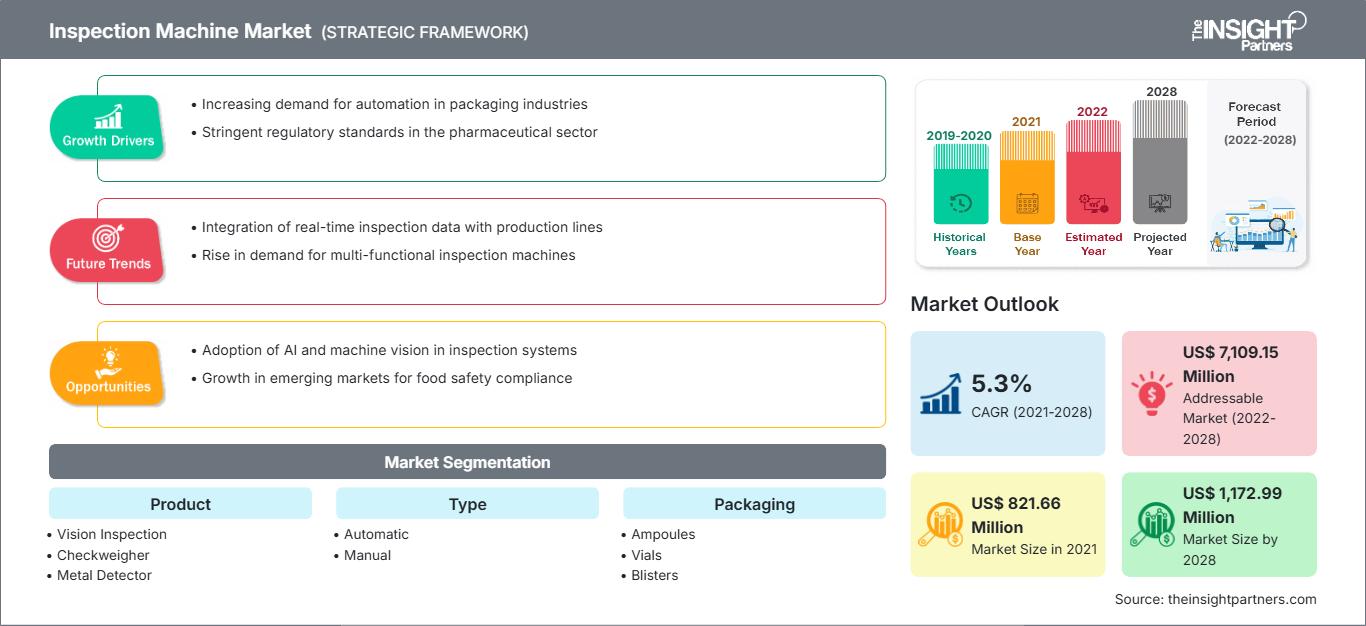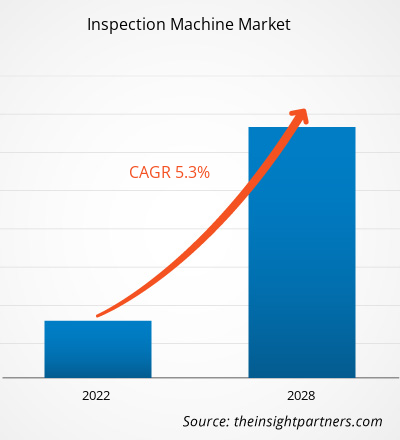Der Markt für Inspektionsmaschinen soll von 821,66 Millionen US-Dollar im Jahr 2021 auf 1.172,99 Millionen US-Dollar im Jahr 2028 anwachsen; das Wachstum wird von 2021 bis 2028 auf durchschnittlich 5,3 % geschätzt.
Inspektionsmaschinen bieten Designern und Ingenieuren Werkzeuge für die Verarbeitung von Geräten und unterstützen sie bei Aufgaben wie dem Sortieren von Spritzen, Blistern, Kathetern, Pillen und Hochgeschwindigkeitsinspektionen. Diese Maschinen umfassen Systeme wie Metalldetektoren, Sauerstoff- und Druck-/Feuchtigkeitsprüfsysteme sowie Lecksuchsysteme. Der Bericht bietet eine detaillierte Analyse des Marktes für Inspektionsmaschinen und legt dabei den Schwerpunkt auf Markttrends, technologische Fortschritte, Marktdynamik und die Wettbewerbslandschaft (unter Einbeziehung wichtiger Marktteilnehmer weltweit). Er berücksichtigt auch die Auswirkungen der COVID-19-Pandemie auf den Markt in allen Regionen. Der Markt für Inspektionsmaschinen ist nach Regionen in Nordamerika, Europa, Asien-Pazifik (APAC), Naher Osten und Afrika (MEA) sowie Süd- und Mittelamerika (SAM) unterteilt.
Passen Sie diesen Bericht Ihren Anforderungen an
Sie erhalten kostenlos Anpassungen an jedem Bericht, einschließlich Teilen dieses Berichts oder einer Analyse auf Länderebene, eines Excel-Datenpakets sowie tolle Angebote und Rabatte für Start-ups und Universitäten.
Markt für Inspektionsmaschinen: Strategische Einblicke

-
Holen Sie sich die wichtigsten Markttrends aus diesem Bericht.Dieses KOSTENLOSE Beispiel umfasst Datenanalysen, die von Markttrends bis hin zu Schätzungen und Prognosen reichen.
Nordamerika hatte 2021 den größten Marktanteil. Das Wachstum des nordamerikanischen Marktes ist auf die positive Einstellung von Männern und Frauen gegenüber der Nutzung von Inspektionsmaschinen, die steigende Zahl von Online-Einzelhändlern und die zunehmende Zahl innovativer Produkteinführungen zurückzuführen. Darüber hinaus dürften die steigenden Ausgaben von Sextechnologieunternehmen das Wachstum des nordamerikanischen Marktes für Inspektionsmaschinen im Prognosezeitraum ankurbeln.
Markteinblicke
Kontinuierlicher Fortschritt bei Vorschriften zur Vorschrift der GMP-Konformität im Gesundheitswesen
Die Einhaltung von GMP im Gesundheitswesen ist ein entscheidendes und schnell wachsendes Feld, da es sich um eine der stark regulierten Branchen handelt. Verschiedene Regulierungsbehörden konzentrieren sich auf die Lösung von Problemen der öffentlichen Gesundheit bei der Einführung und Umsetzung verschiedener öffentlicher Gesundheits- und Wohlfahrtsprogramme. Viele dieser Einrichtungen arbeiten koordiniert zusammen, um die öffentliche Gesundheit auf allen Ebenen zu erhalten und zu regulieren. Private Organisationen sowie Bundes-, Landes- und Kommunalverwaltungen tragen zur Entwicklung und Umsetzung von Gesundheitsvorschriften bei. Regulierungsbehörden wie die US-amerikanische Food and Drug Administration (FDA), die Europäische Arzneimittel-Agentur und die Pharmaceuticals and Medical Devices Agency (Japan) überwachen die Einhaltung der aktuellen Good Manufacturing Practices (cGMP) durch die Hersteller als einen der wichtigsten Schritte in der Qualitätssicherung von Arzneimitteln und Medizinprodukten. Die CGMP empfiehlt Mindestkriterien für Verfahren, Einrichtungen und Kontrollen, die bei der Herstellung, Verarbeitung und Verpackung von pharmazeutischen und medizinischen Produkten erforderlich sind. Darüber hinaus stellen solche Beschränkungen auch sicher, dass die jeweiligen Produkte die angegebenen Inhaltsstoffe enthalten und die versprochene Stärke aufweisen.
Die regulatorischen Überwachungsprozesse für medizinische Innovationen werden in verschiedenen Ländern überarbeitet. Die Europäische Union (EU) hat die neue Medizinprodukteverordnung (MDR) umgesetzt, die die Herstellung und den Vertrieb von Medizinprodukten in der Region kontrolliert und bei der Produktregulierung einen Lebenszyklusansatz verfolgt. Darüber hinaus veröffentlichte China Ende 2017 36 „Stellungnahmen zur Vertiefung der Reform des Bewertungs- und Zulassungssystems und zur Förderung der Innovation bei Arzneimitteln und Medizinprodukten“. Im Juni 2020 veröffentlichte die US-amerikanische Food and Drug Administration (FDA) zudem einen endgültigen Leitfaden zu Inspektionen von Medizinproduktebetrieben. Somit treibt die kontinuierliche Weiterentwicklung der regulatorischen Standards zur Sicherstellung der Konformität im Gesundheitssektor das Wachstum des Marktes für Inspektionsmaschinen voran.
Produktbasierte Einblicke
Der Markt für Inspektionsmaschinen ist nach Produkten segmentiert in Sichtprüfsysteme, Röntgeninspektionssysteme, Kontrollwaagen, Metalldetektoren, Software und mehr. Das Segment der Sichtprüfsysteme hatte 2021 den größten Marktanteil und dürfte im Prognosezeitraum auch die höchste durchschnittliche jährliche Wachstumsrate von 5,9 % verzeichnen.
Typbasierte Einblicke
Der Markt für Inspektionsmaschinen ist nach Typen unterteilt in automatische und manuelle. Das automatische Segment hatte 2021 einen größeren Marktanteil und dürfte im Prognosezeitraum auch eine höhere CAGR von 5,4 % verzeichnen.
Verpackungsbasierte Erkenntnisse
Der Markt für Inspektionsmaschinen ist nach Verpackung in Ampullen, Fläschchen, Blister und Flaschen unterteilt. Das Ampullensegment hatte 2021 den größten Marktanteil und dürfte im Prognosezeitraum die höchste CAGR von 6,0 % verzeichnen.
Endbenutzerbasierte Erkenntnisse
Der Markt für Inspektionsmaschinen ist nach Endbenutzer in Pharma- und Biotechnologieunternehmen, Hersteller medizinischer Geräte sowie Lebensmittelverarbeitungs- und Verpackungsunternehmen unterteilt. Der Pharma- und Das Segment der Biotechnologieunternehmen hatte im Jahr 2021 den größten Marktanteil und es wird erwartet, dass dasselbe Segment im Prognosezeitraum die höchste durchschnittliche jährliche Wachstumsrate (CAGR) von 5,4 % verzeichnet.
Die Akteure auf dem Markt für Inspektionsmaschinen verfolgen organische Strategien wie Produkteinführung und -erweiterung, um ihre Präsenz und ihr Produktportfolio weltweit zu erweitern und die wachsende Nachfrage zu befriedigen.
Inspektionsmaschine
Regionale Einblicke in den Markt für Inspektionsmaschinen
Die Analysten von The Insight Partners haben die regionalen Trends und Faktoren, die den Markt für Inspektionsmaschinen im Prognosezeitraum beeinflussen, ausführlich erläutert. In diesem Abschnitt werden auch die Marktsegmente und die geografische Lage in Nordamerika, Europa, dem asiatisch-pazifischen Raum, dem Nahen Osten und Afrika sowie Süd- und Mittelamerika erörtert.
Umfang des Marktberichts über Inspektionsmaschinen
| Berichtsattribut | Einzelheiten |
|---|---|
| Marktgröße in 2021 | US$ 821.66 Million |
| Marktgröße nach 2028 | US$ 1,172.99 Million |
| Globale CAGR (2021 - 2028) | 5.3% |
| Historische Daten | 2019-2020 |
| Prognosezeitraum | 2022-2028 |
| Abgedeckte Segmente |
By Produkt
|
| Abgedeckte Regionen und Länder |
Nordamerika
|
| Marktführer und wichtige Unternehmensprofile |
|
Dichte der Marktteilnehmer für Inspektionsmaschinen: Verständnis ihrer Auswirkungen auf die Geschäftsdynamik
Der Markt für Inspektionsmaschinen wächst rasant. Dies wird durch die steigende Endverbrauchernachfrage aufgrund veränderter Verbraucherpräferenzen, technologischer Fortschritte und eines stärkeren Bewusstseins für die Produktvorteile vorangetrieben. Mit der steigenden Nachfrage erweitern Unternehmen ihr Angebot, entwickeln Innovationen, um den Verbraucherbedürfnissen gerecht zu werden, und nutzen neue Trends, was das Marktwachstum weiter ankurbelt.

- Holen Sie sich die Markt für Inspektionsmaschinen Übersicht der wichtigsten Akteure
Nach Produkt
- Vision-Inspektionssysteme
- Röntgeninspektionssysteme
- Kontrollwaagen
- Metalldetektoren
- Software
- Andere
Nach Verpackung
- Ampullen
- Fläschchen
- Blister
- Flaschen
Nach Typ
- Automatisch
- Manuell
Nach Endbenutzer
- Pharmazeutika & Biotechnologieunternehmen
- Hersteller medizinischer Geräte
- Lebensmittelverarbeitung & Verpackungsunternehmen
Nach Geografie
- Nordamerika
- USA
- Kanada
- Mexiko
- Europa
- Frankreich
- Deutschland
- Italien
- Großbritannien
- Spanien
- Übriges Europa
- Asien-Pazifik (APAC)
- China
- Indien
- Südkorea
- Japan
- Australien
- Rest von APAC
- Naher Osten und Asien Afrika (MEA)
- Südafrika
- Saudi-Arabien
- VAE
- Rest von MEA
- Süd- und Mittelamerika (SCAM)
- Brasilien
- Argentinien
- Rest von SCAM
Firmenprofile
- OMRON Corporation
- THERMO FISHER SCIENTIFIC INC.
- Cognex Corporation
- Syntegon Technology GmbH (Bosch Packaging Technology)
- METTLER TOLEDO
- Teledyne Technologies Incorporated
- General Inspection LLC
- BREVETTI CEA SPA
- Körber AG.
- Minebea Intec GmbH
- Historische Analyse (2 Jahre), Basisjahr, Prognose (7 Jahre) mit CAGR
- PEST- und SWOT-Analyse
- Marktgröße Wert/Volumen – Global, Regional, Land
- Branchen- und Wettbewerbslandschaft
- Excel-Datensatz
Aktuelle Berichte
Verwandte Berichte
Erfahrungsberichte
Grund zum Kauf
- Fundierte Entscheidungsfindung
- Marktdynamik verstehen
- Wettbewerbsanalyse
- Kundeneinblicke
- Marktprognosen
- Risikominimierung
- Strategische Planung
- Investitionsbegründung
- Identifizierung neuer Märkte
- Verbesserung von Marketingstrategien
- Steigerung der Betriebseffizienz
- Anpassung an regulatorische Trends






















 Kostenlose Probe anfordern für - Markt für Inspektionsmaschinen
Kostenlose Probe anfordern für - Markt für Inspektionsmaschinen